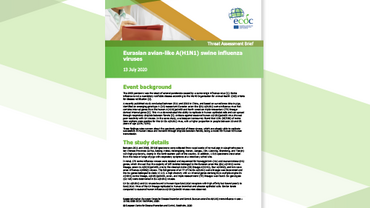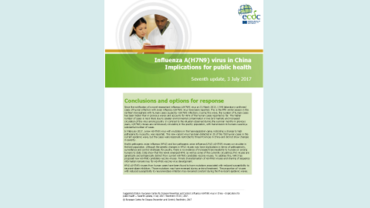Rapid Risk Assessment: Human infection with influenza virus A(H7N9) virus - 4th update, 3 February 2015
This fourth update of the risk assessment on human infection with avian influenza A(H7N9) virus, summarises the epidemiological and virological information on the disease in China and Canada, and assesses the risk to public health in the EU/EEA and to EU/EEA citizens.
Executive Summary
The first two cases of A(H7N9) in North America following travel to China highlight the possibility that imported cases to Europe are possible but community-level spread following importation is unlikely as the virus does not transmit easily among people. ECDC has updated its rapid risk assessment in light of this even but the main conclusions are not altered.
On 26 January 2015, the Public Health Agency of Canada announced the detection of influenza A(H7N9) infection in a resident of British Columbia upon return from China. The case was diagnosed through routine testing while attending a general practice with mild flu symptoms. On the 29 January 2015, a second case, with the same travel history and close contact to the first case, tested positive for influenza A(H7N9). Neither case required hospitalisation and both are recovering at home.
Since the notification of a novel reassortant influenza A(H7N9) virus on 31 March 2013, a total of 488 laboratory confirmed cases of human infection with avian influenza A(H7N9) virus, including 185 deaths, have been reported, the vast majority in China.
Live poultry markets
The majority of recently reported human cases are associated with exposure to infected live poultry or contaminated environments, including markets where live poultry are sold. Influenza A(H7N9) viruses continue to be detected in poultry and their environments in the areas where human cases are occurring. Information to date does not support sustained human-to-human transmission.
At present, the most immediate threat to EU citizens is to those living or visiting influenza A(H7N9)-affected areas in China. It is advisable to avoid live bird markets and contact with live poultry and avoid consuming raw or incompletely cooked meat products and eggs.
Community-level spread in following importation into Europe is unlikely as the virus does not transmit easily among people. Nonetheless, travellers developing severe respiratory or flu-like symptoms within ten days after travel to affected areas and exposure to poultry or untreated poultry products in China should be rapidly managed and appropriately sampled for influenza testing.







